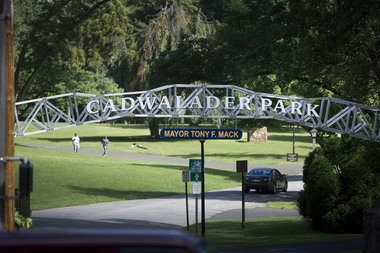Signage Debacle Highlights Misallocation of Funds in Local Government
In Trenton, New Jersey, this $17,000 sign was removed almost immediately after its unveiling (via NJ.com).
June 29, 2012 — A new sign at Trenton’s Cadwalader Park has many local residents of the New Jersey city confused, concerned, and angry. On Monday, the park’s new sign, designed to look like a local landmark bridge, was unveiled, only to be taken down almost immediately. The parks and recreation department, with its $1.3 million annual budget, failed to realize that it needed the approval of the city’s landmarks commission for historic preservation. Some locals are frustrated by the city government’s thick red tape, while others point to a lack of competence on the part of the individuals therein. It’s sad (if a little amusing) that no one in the Parks and Recreation Department seemed to know that one of the parks is on the national registry or that a new sign would need to be approved by another bureaucratic subdivision.
Regardless of the department’s overall competence, these concerns all seem to be a part of larger issues; both the city’s level of funding and its allocation of funds are, at least on the surface, pretty poor. In September, 108 Trenton police officers, representing a third of the police force, were laid off in an effort to find some last-minute savings. This is in an area where the rate of violent crimes in 2006 was almost three times the national rate, and that’s before the mass police layoff. While it’s clear that having spaces like parks may also help reduce crime rates, the immediacy of the city’s problems with violent crime make the severe police force reduction completely unjustifiable, especially when the parks department is budgeted $17,000 for a sign that had to be taken down almost immediately. Reportedly, $10,000 of that came from a recreation and natural resources line item for printing and binding, which presumably couldn’t have been used to save police officers’ jobs anyway.
Using smaller, less ostentatious signs can be more affordable than larger ones that look like local landmarks .
In similar instances, the reasoning often seems similarly plausible when evaluated in the context of miles of red tape. In Lakeville, Minnesota, the District 194 school board opted to spend $1.5 million in 2008 to replace the grass on one of its high school’s athletic fields with artificial turf. In the same year, due to a failed bond referendum, the very same school board cut a number of teaching positions. Needless to say, as in Trenton, a number of local voters were none too pleased. But the school board offered up a similar explanation, noting that the funds were from completely different accounts that were earmarked for specific purposes. While no one doubted the veracity of the board’s claim, the layers of bureaucracy implicit within the justification are irritating. After all, how hard can it really be to transfer some funds so that kids can have smaller class sizes instead of having shiny fake grass on their football fields? While this is clearly an oversimplification of the issue, the principle remains.
The turf on this high school athletic field in Lakeville, Minnesota, was replaced in a year of heavy educational budget cuts (via Sprinturf.com).
Really, though, the issues in both Trenton and Lakeville could have been solved with an increase in funding. In Trenton, it’s difficult to say where that extra funding would come from, as the city’s median income is less than half of the overall median household income in New Jersey. In this case, the city simply needs to be more resourceful and better allocate its funds to issues that really matter. In a city with such high rates of violent crime, it seems like common sense to fund a stronger police presence in lieu of a parks system with enough funding to spend thousands on a sign.
Lakeville, on the other hand, just needs its citizens to be better informed about how the world works. In Lakeville, as in all places that can afford to pass a bond referendum to make the school system competitive, the people need to realize that a few extra dollars in property taxes can really only help by improving the quality of the local schools, which, in turn, increases local property values. Clearly, the situation is nowhere near as dire as in Trenton, but upper-middle-class suburban towns can stand to learn a few lessons in financial responsibility.
None of this is to say that local government is inherently inefficient. In fact, most are clearly trying to do the best with whatever resources they are given. Trenton could really stand to allocate its monetary resources more efficiently (and maybe hire some more competent employees) in order to obviate the locals’ problems with the city’s questionable budgetary habits. Lakeville would benefit from better school systems and citizens that opt to pass bond referenda. Both of these cities clearly have a problem or two with funding some of their local endeavors, but in reality, they’re just like myriad other towns and cities throughout the country. Most everywhere could benefit from some funding reallocation, and most everywhere is spending money in places that many would consider wasteful. With limited resources, it’s impossible to please everyone, and with that in mind, it’s important to acknowledge that there are often more effective ways to spend local government money.
– T. Caruso
Related Posts
Category: News




















